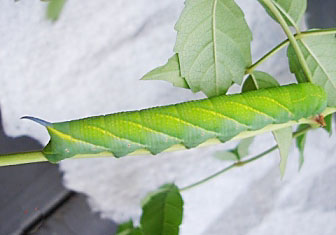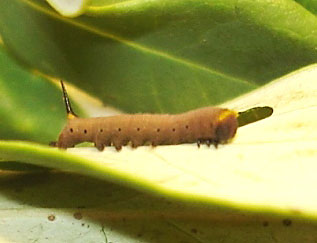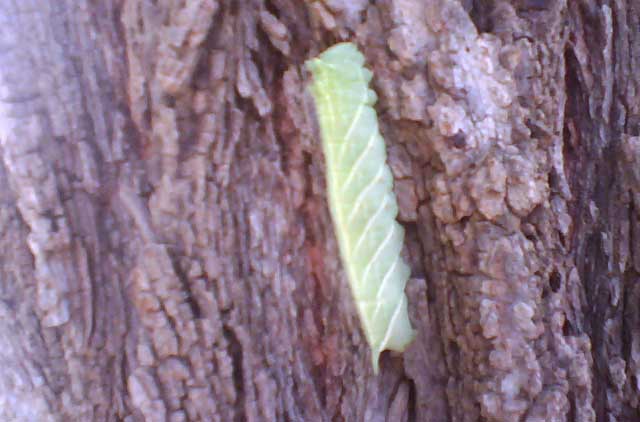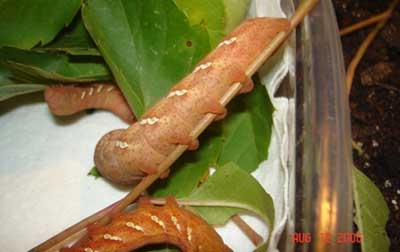Oklahoma County, Oklahoma
Sphingidae Larvae


This page is inspired by and dedicated to Susan Johnston who sent me the image of Paratrea plebeja at
the top of the page, the image of the early instar Hemaris diffinis below, and the image of Eumorpha achemon at bottom of page.
Susan writes, "I also just sent a pic to "What's That Bug?" of a Plebeian Sphinx cat I found on trumpet creeper. Your website has
been of GREAT help to me in ID'ing many of the moths I raise and I thank you for that.
"I'm at a loss to definitely ID this caterpillar as a Hemaris diffinis found on honeysuckle. While there are
similarities to the green form, this cat is entirely brown and not more than a first instar cat. I have read much material on the
Internet which states that Hemaris may turn brown in the later instars, but this is very early, and I don't know for sure if it is
the same species, just a brown form, or not. |
 |
" I would appreciate if you could give me your expert opinion. I live in Oklahoma City, Oklahoma, in zone 7a, and the cat was found, among other numerous typical green forms, on my honeysuckle, which they frequent every year."
I wrote back, "Yes, it is Hemaris diffinis. Many of the Sphingidae show variation in colour and patterning in the larval stages. I had not seen a small brown one before, however."
Bob Heckman sent this image of a Ceratomia amyntor larva.

Ceratomia amyntor, climbing an elm tree, September 23, 2007,
Mid West City, Oklahoma County, Oklahoma, courtesy of Bob Heckman.
"I Could not believe the adaptation to look like the elm leaf. I have found several similar looking caterpillars in searching hundreds of pics, but none that looked exactly like this one.
"If you know what kind of moth or butterfly this becomes, I would sure appreciate knowing."
I suspect the caterpillar either fell from the tree during a wind/rain storm, or may have been dislodged/dropped by a bird. At maturity, Sphingidae larvae descend the host plant and pupate amongst leaf litter or in subterranena chambers.
For care of "found larvae/caterpillars" visit Manduca sexta larva, central Texas, August 21, 2008, Trina Woodall.
It is hoped that this checklist, with the thumbnails and notes, will help you quickly identify the larvae (caterpillars) you have encountered.
A "WO" after the species name indicates that I have no confirmed reports of this species in Oklahoma County, but I (William Oehlke) expect that this species is present or might be present.
A USGS indicates the moth is reported on the USGS website and/or in Moths of Western North America, #2. Distribution of Sphingidae of Western North America, revised, an excellent little booklet available through Paul Opler.
Please help me develop this list with improved, documented accuracy by sending sightings (species, date, location), preferably with an image, via email to Bill Oehlke.
Sphinginae subfamily
Smerinthini Tribe:
Macroglossinae subfamilyDilophonotini tribe
Philampelini tribe:
Macroglossini tribe
|
Eumorpha achemon, Ashby, Oklahoma, August 12, 2005, courtesy of Susan Johnston.Susan writes, "Eumorpha achemon: you can now confirm its presence in Oklahoma County. I've attached the photos of the caterpillars I found on Virginia Creeper in my backyard. I raised about nine of them." |  |
Eggs of many North American species are offered during the spring and summer. Occasionally summer Actias luna and summer Antheraea polyphemus cocoons are available. Shipping to US destinations is done from with in the US.
Use your browser "Back" button to return to the previous page.
This page is brought to you by Bill Oehlke and the WLSS. Pages are on space rented from Bizland. If you would like to become a "Patron of the Sphingidae Site", contact Bill.
Please send sightings/images to Bill. I will do my best to respond to requests for identification help.
 Show appreciation for this site by clicking on flashing butterfly to the left. The link will take you to a page with links to many insect sites. |
I very much appreciate all the many images that have been sent to me, or of which I have been granted permission to copy and post from other websites. All images on this site remain the property of respective photographers.
If you would like to contribute to the maintenace of this website by sending a contribution to
Bill Oehlke
Box 476
155 Peardon Road
Montague, Prince Edward Island, C0A1R0
Canada
your donation would be much appreciated and would be used for
1) paying for webspace rental;
2) paying for computer maintenance and software upgrades;
3) purchases of additional text reference material (journals and books) in anticipation of expanding the site to a worldwide Sphingidae site;
4) helping to pay my daughter's tuition (completed spring 2013); with anything left over going to humanitarian aid.
If you are mailing a check from USA, please use $0.85 postage. $1.15 is 2014 postal rate so best to check with post office as rates are increasing almost annually ($1.25 is 2016 rate). Donations can also be made through Paypal via the button below.